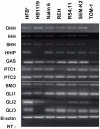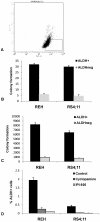Self-renewal of acute lymphocytic leukemia cells is limited by the Hedgehog pathway inhibitors cyclopamine and IPI-926
- PMID: 21203400
- PMCID: PMC3011010
- DOI: 10.1371/journal.pone.0015262
Self-renewal of acute lymphocytic leukemia cells is limited by the Hedgehog pathway inhibitors cyclopamine and IPI-926
Abstract
Conserved embryonic signaling pathways such as Hedgehog (Hh), Wingless and Notch have been implicated in the pathogenesis of several malignancies. Recent data suggests that Hh signaling plays a role in normal B-cell development, and we hypothesized that Hh signaling may be important in precursor B-cell acute lymphocytic leukemia (B-ALL). We found that the expression of Hh pathway components was common in human B-ALL cell lines and clinical samples. Moreover, pathway activity could be modulated by Hh ligand or several pathway inhibitors including cyclopamine and the novel SMOOTHENED (SMO) inhibitor IPI-926. The inhibition of pathway activity primarily impacted highly clonogenic B-ALL cells expressing aldehyde dehydrogenase (ALDH) by limiting their self-renewal potential both in vitro and in vivo. These data demonstrate that Hh pathway activation is common in B-ALL and represents a novel therapeutic target regulating self-renewal and persistence of the malignant clone.
Conflict of interest statement
Figures






Similar articles
-
Impact of the Smoothened inhibitor, IPI-926, on smoothened ciliary localization and Hedgehog pathway activity.PLoS One. 2014 Mar 7;9(3):e90534. doi: 10.1371/journal.pone.0090534. eCollection 2014. PLoS One. 2014. PMID: 24608250 Free PMC article.
-
Hedgehog pathway inhibition in chondrosarcoma using the smoothened inhibitor IPI-926 directly inhibits sarcoma cell growth.Mol Cancer Ther. 2014 May;13(5):1259-69. doi: 10.1158/1535-7163.MCT-13-0731. Epub 2014 Mar 14. Mol Cancer Ther. 2014. PMID: 24634412
-
Response to inhibition of smoothened in diverse epithelial cancer cells that lack smoothened or patched 1 mutations.Int J Oncol. 2012 Nov;41(5):1751-61. doi: 10.3892/ijo.2012.1599. Epub 2012 Aug 22. Int J Oncol. 2012. PMID: 22923130 Free PMC article.
-
Inhibiting Hedgehog: An Update on Pharmacological Compounds and Targeting Strategies.J Med Chem. 2019 Sep 26;62(18):8392-8411. doi: 10.1021/acs.jmedchem.9b00188. Epub 2019 Apr 24. J Med Chem. 2019. PMID: 30986059 Review.
-
Blockade of hedgehog signaling pathway as a therapeutic strategy for pancreatic cancer.Cancer Lett. 2009 Oct 8;283(2):119-24. doi: 10.1016/j.canlet.2009.01.014. Epub 2009 Feb 15. Cancer Lett. 2009. PMID: 19232458 Review.
Cited by
-
Stromal cells expressing hedgehog-interacting protein regulate the proliferation of myeloid neoplasms.Blood Cancer J. 2012 Sep 7;2(9):e87. doi: 10.1038/bcj.2012.36. Blood Cancer J. 2012. PMID: 22961059 Free PMC article.
-
Hedgehog signaling: networking to nurture a promalignant tumor microenvironment.Mol Cancer Res. 2011 Sep;9(9):1165-74. doi: 10.1158/1541-7786.MCR-11-0175. Epub 2011 Jul 20. Mol Cancer Res. 2011. PMID: 21775419 Free PMC article. Review.
-
Cancer stem cells: relevance to SCT.Bone Marrow Transplant. 2009 Apr;43(7):517-23. doi: 10.1038/bmt.2009.19. Epub 2009 Feb 23. Bone Marrow Transplant. 2009. PMID: 19234507 Free PMC article. Review.
-
Hedgehog pathway mutations in T-cell acute lymphoblastic leukemia.Haematologica. 2015 Mar;100(3):e102-5. doi: 10.3324/haematol.2014.119248. Epub 2014 Dec 19. Haematologica. 2015. PMID: 25527561 Free PMC article. No abstract available.
-
The controversial role of the Hedgehog pathway in normal and malignant hematopoiesis.Leukemia. 2011 Nov;25(11):1665-73. doi: 10.1038/leu.2011.143. Epub 2011 Jun 10. Leukemia. 2011. PMID: 21660044 Free PMC article. Review.
References
-
- Ingham P, McMahon A. Hedgehog signaling in animal development: paradigms and principles. Genes Dev. 2001;15:3059–3087. - PubMed
-
- Weng AP, Ferrando AA, Lee W, Morris JP, Silverman LB, et al. Activating mutations of NOTCH1 in human T cell acute lymphoblastic leukemia. Science. 2004;306:269–271. - PubMed
-
- Ji Z, Mei F, Johnson B, Thompson E, Cheng X. Protein kinase A, not Epac, suppresses hedgehog activity and regulates glucocorticoid sensitivity in acute lymphoblastic leukemia cells. J Biol Chem. 2007;282:37370–37377. - PubMed
-
- Kawahara T, Kawaguchi-Ihara N, Okuhashi Y, Itoh M, Nara N, et al. Cyclopamine and quercetin suppress the growth of leukemia and lymphoma cells. Anticancer Res. 2009;29:4629–4632. - PubMed
-
- Warzecha J, Bonke L, Koehl U, Munkelt D, Göttig S, et al. The hedgehog inhibitor cyclopamine induces apoptosis in leukemic cells in vitro. Leuk Lymphoma. 2008;49:2383–2386. - PubMed
Publication types
MeSH terms
Substances
Grants and funding
LinkOut - more resources
Full Text Sources
Other Literature Sources
Miscellaneous

